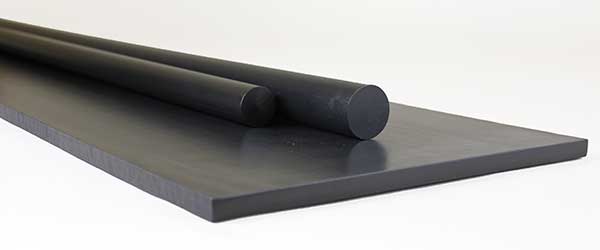 Solvay’s KetaSpire PEEK polymer family of products serves an array of automotive, aerospace, oil and gas, and manufacturing applications. The development of its high-temperature PEEK XT grades for injection molding and for extrusion into machinable shapes extends the polymer’s application range to higher operating temperature levels beyond the capabilities of traditional PEEK resins.
Solvay’s KetaSpire PEEK polymer family of products serves an array of automotive, aerospace, oil and gas, and manufacturing applications. The development of its high-temperature PEEK XT grades for injection molding and for extrusion into machinable shapes extends the polymer’s application range to higher operating temperature levels beyond the capabilities of traditional PEEK resins.
PEEK XT has been purpose-developed for extremely high temperature and pressure environments like those found in offshore oil and gas applications. Previously, oil and gas fleets had difficulty sourcing a material that could withstand high temperatures and chemical attack simultaneously, and could be converted efficiently by melt-processing into machinable shapes and injection molded parts. PEEK XT has all three, along with an impressive list of overall mechanical properties.
Testing in severe service conditions supports its performance. Of particular note is its performance related to Norsok’s M710 standard, which includes specifications for exposure to sour gas, brine and hydrocarbons. The test results confirm PEEK XT’s capability to perform in challenging oil and gas applications.
PEEK XT Performance in Norsok Sour Gas Testing

PEEK XT’s performance in Norsok testing makes it a good choice for sealing applications that have been beyond the thermal limits of traditional PEEK grades.
Norsok standards were developed by the Norwegian petroleum industry and adopted by oil and gas companies around the world. They’re considered some of the toughest standards, and are used to qualify materials for harsh offshore environments.
In 2020, Solvay subjected PEEK XT to Norsok M710 testing; specifically, the sour gas and brine/hydrocarbon tests. Sour gas testing involves placing the material sample in an autoclave and exposing it to hydrogen sulfide gas (20 percent concentration). Sour gas, which is found in one-third of all U.S. natural gas deposits, is rich in hydrogen sulfide.
Throughout M710 testing, PEEK XT was able to maintain its considerable strength. After 14 days of exposure, PEEK XT demonstrated tensile strength of >80 Mpa . After 56 days of testing, the polymer’s tensile strength still measured >60 Mpa, easily surpassing test requirements. PEEK XT was also able to maintain its tensile strength (>80Mpa) following 14 days of exposure to brine and hydrocarbons at 300oC. These test results enable oil and gas engineers to capitalize on the inherent performance attributes of PEEK for applications exposed to temperatures higher than previously possible with the polymer.
The Difference Between PEEK XT and Other High-Temperature Polyaryletherketone Polymers
High temperature polymers within the polyaryletherketone family include PEEK, PEK, PEKK and PEKEKK. Each has a different ether ( E ) to ketone (K) ratio in its polymeric structure. These differences impart different performance characteristics. For example, while all exhibit a high degree of chemical resistance, PEEK withstands exposure to a wider spectrum of chemicals than the other polymers in this family. As a true PEEK polymer, PEEK XT demonstrates the same capability.
Thermal properties
Chemical resistance
One of the more significant differences among these high-performance polymers is their chemical resistance. Norsok M710 testing demonstrated PEEK XT’s unmatched chemical stability, a characteristic imparted by its unique 2 to 1 ether-to-ketone ratio as a true PEEK polymer.
PEKK, PEK and PEKEKK all experienced near-total losses of tensile strength after 14 days of sour gas and brine/hydrocarbon testing. These polymers contain more ketone groups, which make the polymer structure more susceptible to chemical attack.
Processability
PEEK XT Improves on Traditional PEEK’s Physical Properties
PEEK and PEEK XT have similar polymeric structures with their identical 2 to 1 ether-to-ketone ratio. As mentioned, this ratio is what makes PEEK XT a true PEEK polymer. Both polymers possess some similar physical properties at ambient temperatures. The differences between these two advanced polymers are most evident when certain properties are measured at high temperatures.
This summary compares tensile modulus and tensile strength for both high-performance plastics across various temperatures:
- 23oC (room temperature): PEEK has a tensile modulus of 3500 MPa and a tensile strength of 95 MPa. PEEK XT has the same tensile modulus and strength at this temperature.
- 160oC: PEEK has tensile modulus of 700 MPa and tensile strength of 24 MPa. At this temperature, PEEK XT’s tensile modulus is 2790 MPa and its tensile strength is 35 MPa.
- 175oC: PEEK has a tensile modulus of 360 MPa and a tensile strength of 22 MPa. PEEK XT has a nearly threefold advantage with a tensile modulus of 1050 MPa. Its tensile strength measures 31 MPa.
PEEK XT’s superior tensile modulus and strength at elevated temperatures are the key performance assets that open the inherent advantages of PEEK to higher temperature applications.
PEEK XT Couples Superior Thermal Properties with Traditional Benefits of PEEK
PEEK XT is an appropriate material for components exposed to higher temperatures than traditional grades of PEEK can withstand. However, it also maintains the resistance to wear, physical loads and chemical attack that characterizes the PEEK polymer. That makes it a good choice for bushings, seals, bearings, and other high-wear components that had been out of reach for PEEK previously. With its excellent dielectric strength and resistivity, PEEK XT is also an effective choice for insulators and other components that must resist electrical flow.
Processing Expertise is Needed to Optimize PEEK XT Performance

30% carbon fiber reinforced KetaSpire PEEK XT-920 CF 30 is available in a range of extruded rod diameters and plate thicknesses for machining precision components for oil and gas equipment. Other grades available are unreinforced PEEK XT-920, and 30% glass-fiber reinforced PEEK XT-920 GF30. (Photo: Drake Plastics)
Tightly controlled melt process conditions and specialized equipment are requisites for optimizing an advanced polymer’s properties during injection molding, extrusion and machining. PEEK XT falls into this category. The right equipment set-up for the material, coupled with accurate process monitoring and control systems, is essential. These investments yield consistent process conditions for repeatable high quality finished products. They preclude material degradation at high process temperatures and prevent voids that can occur in heavier cross sections.
A well-qualified specialist in melt processing and machining high-performance plastics will have the production technology, the quality management system and the experience required. These combined capabilities will yield consistent quality PEEK XT shapes and parts that achieve the polymer’s optimum level of performance.
